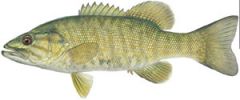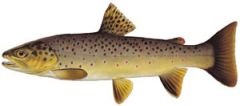![]()
![]()
![]()
Use LEFT and RIGHT arrow keys to navigate between flashcards;
Use UP and DOWN arrow keys to flip the card;
H to show hint;
A reads text to speech;
14 Cards in this Set
- Front
- Back
|
Brown Trout (pic)
|

|
|
|
Brook Trout (pic)
|

|
|
|
Steelhead (pic)
|

|
|
|
Largemouth Bass (pic)
|

|
|
|
Smallmouth Bass (pic)
|

|
|
|
Rainbow Trout (pic)
|

|
|
|
Brown Trout (pic)
|

|
|
|
Largemouth Bass
|
•Cheek scales same size as rest of body scales
•Green with dark horizontal stripe •Without rows of dark spots •Upper jaw extends beyond back of eye •Smooth tongue •Dorsal fins not well connected Typically 1-3 lbs, but can reach 15 lbs, found in warm-water lakes and slow-moving water associated with weeds and structure |
|
|
Smallmouth Bass
|
•Cheek scales much smaller than rest of body scales
•Bronze and greenish-brown color •No dark horizontal stripe •Without rows of dark spots •Upper jaw does not extend beyond back of eye •Tongue usually has rough patch •Dorsal fins connected Cool-water, found in clear, rocky habitats, Avg 1-2 lbs but can reach 8lbs. Jump spectacularly when hooked. |
|
|
Rainbow Trout
|
Silvery-gray to dark-green on the back and sides
Pinkish or reddish lateral stripe, sometimes with lavendar or orange overtones, from the gill cover running the length of the fish to the tail The caudal fin has rows of small dark spots, and there are more small blackish spots sprinkled on the head and sides Spotting on the dorsal and adipose fins. Belly is whitish. Lower fins are pale-pink without spots At spawning time, males become deeply colored with an intensely red side stripe. Steelhead can be separated from similar-looking coho and chinook salmon by looking at the inside of the mouth. The mouth is completely white in the steelhead. In the salmons, the mouth has some gray or black. Steelhead and other deepwater, big-lake rainbows are more silvery than stream fish, with less of a side stripe. Great Lakes steelhead can grow to 30 inches and larger |
|
|
Brook Trout
|
General body color is dark-green. Its back is dark olive-green or gray-green, mottled with dark, squiggly or wormlike markings from head to tail.
Sides and belly shade lighter, sometimes with green, gray or even lavendar tones, and additional irregular marks. Sides also have scattered red dots, surrounded by bright-blue halos. Belly is usually pale yellow-orange, with a blackish or gray streak down the middle. Pectoral, pelvic and anal fins are pale to bright-orange with a white leading edge followed by a black stripe. There are dark blotches on the dorsal and caudal fins. The brook trout’s tail fin is less forked than that of most trout and salmon. It’s even squarish. In spawning males, colors become more intense and the belly becomes deep-orange. At maturity, wild brook trout may be from five inches to 18 inches long |
|
|
Brown Trout
|
Brown trout are brownish in overall tone.
The back and upper sides are dark-brown to gray-brown, with yellow-brown to silvery lower sides. Large, dark spots are outlined with pale halos on the sides, the back and dorsal fin, with reddish-orange or yellow spots scattered on the sides. Fins are clear, yellow-brown, and unmarked. Belly is white-yellow. Breeding males develop a long, hooked jaw and brighten in color. Wild brown trout in infertile streams may grow only slightly larger than the brook trout there. But in more fertile streams brown trout that weigh a pound are common. A brown trout over 10 pounds is a trophy. Brown trout may exceed 30 inches in length. |
|
|
Lake Trout
|
Body has a background gray color, often with an bronze-olive overtone. Belly shades to silvery-white
Back and sides have many large light-colored, irregularly shaped markings, some of which are wavy or wormlike, like the brook trout’s markings. Light speckling on the dorsal and adipose fins and on the deeply forked caudal fin, plus a white leading edge on the pectoral, pelvic and anal fins. Known to grow to more than 50 inches and reach over 100 pounds |
|
|
Lake Trout (pic)
|

|

